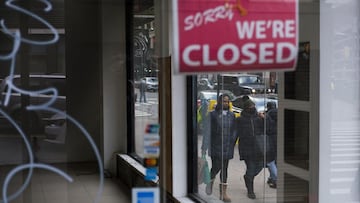$300 Unemployment benefits: how can I track my payment?
Congress extended unemployment benefits for the jobless just as more Americans are once again losing their jobs. Find out how you can track your payments.

In December the US saw its first jobs loss since the start of the recovery with 140,000 new unemployment claims. In April over 20 million people lost their jobs at the onset of the coronavirus induced economic crisis that US has yet to fully recover from . The current unemployment rate held steady at 6.7 percent but is still nearly double the historic low in February 2020 of 3.5 percent.
Fortunately Congress was able to reach a compromise to keep unemployment benefits going into the early months of the incoming Biden administration. A $900 billion bipartisan covid-19 relief package will extend payments for 11 weeks until mid-March giving Americans an additional $300 per week on top of their state benefits. Mixed-income earners in most states will get an extra $100 per week on top of the $300. States are already rolling out the new payments but not all are up and running.
Who is eligible for unemployment benefits?
Normally, unemployment benefits are reserved for full-time employees who lose their jobs. With the expanded coverage, part-time and self-employed workers may now qualify.
The Cares Act created the Pandemic Unemployment Assistance program (PUA), which provides benefits to citizens who would not normally be eligible for unemployment benefits from the states, including gig workers, freelancers, independent contractors and small business owners whose income has been affected by covid-19. For now, PUA funding is set to run from 27 December through 14 March.
You may also be eligible to collect unemployment benefits if:
- You or a family member have been infected by covid-19 and cannot work.
- You have been advised by a doctor to self-quarantine.
- Your workplace closed due to the coronavirus.
- You're not working because you have to care for children or other family members who would otherwise attend school or another facility.
- For college students who worked a job last year - even a part-time one.
Eligibility standards vary from state to state, or territory, to determine what you need to do to receive the money. Best advice is to check with your state unemployment office.
How do I claim for unemployment support?
Contact your state’s unemployment office as soon as possible after becoming unemployed.
You should generally file your claim with the state where you worked. You can find details of each state program and how to file in your state using the U.S. Labor Department’s Unemployment Benefits Finder.
The states are still issuing the filing requirements to apply for the Pandemic Unemployment Assistance program, but generally applicants need to provide 1099 statements of earnings history. If you are already receiving PUA benefits you may have to provide new proof that you were self-employed and lost income during the pandemic.
When it was originally established, people could self-attest that they were eligible for PUA, essentially swearing under oath that they qualified for the aid.
Are benefits the same for everybody?
No. Payment amounts depend on a worker’s prior wages, generally calculated over the last past fiscal year. They also vary significantly between states, which tend to use different formulas to calculate aid. Generally, unemployment insurance in most states replaces between 30–50 percent of lost earnings.
What amount of unemployment benefits will I get?
The average jobless American receives $378 a week in unemployment benefits, according to US Labor Department data from 2019, but this number varies wildly state by state and depends on your individual circumstances. With the extended benefits Americans can receive up to $300 in addition to their state unemployment insurance. In all but two states, Idaho and South Dakota, mixed-income earners may be eligible for an extra $100 per week.
How do I check the status of my unemployment benefit claim?
Related stories
If you've made your initial claim and are waiting for and update, your state’s labor department will have your details so contact them directly by email of phone. Alternatively there may be an online portal on the site to pull up your status automatically online. If you’re not sure how to find the right contact, the government Benefits Finder is a good place to start. Just input your state and you’re away.
Relief bill and second stimulus check: live updates
You can get the latest updates and information on the coronavirus relief bill and second stimulus check by following our dedicated rolling news feed.


